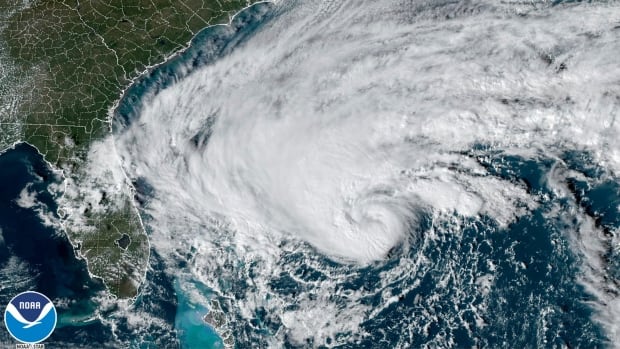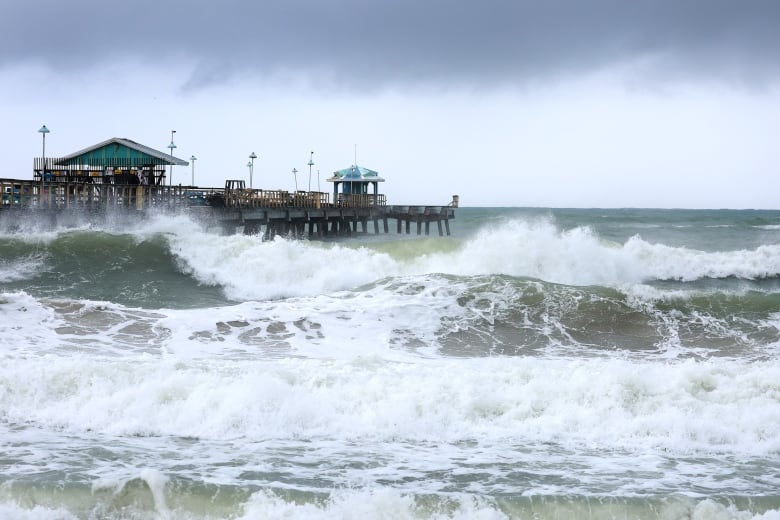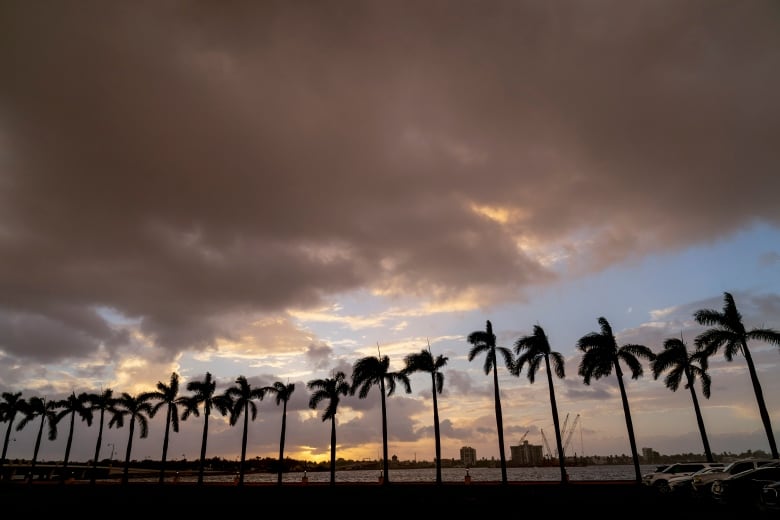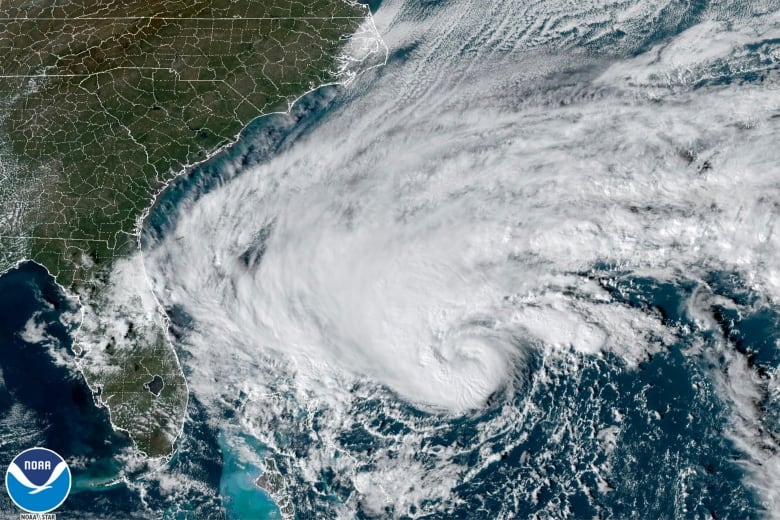
Tropical storm Nicole forced people from their homes in the Bahamas and threatened to grow into a rare November hurricane in Florida on Wednesday — shutting down theme parks and airports while prompting evacuation orders that included former U.S. president Donald Trump’s Mar-a-Lago club.
Hundreds of people sought shelter in the northwestern Bahamas before the approaching storm, which had already sent seawater washing across roads on barrier islands in Florida.
The U.S. National Hurricane Center said the centre of the sprawling storm made landfall on Great Abaco island around midday with estimated maximum sustained winds of 112 km/h.
“We are forecasting it to become a hurricane as it nears the northwestern Bahamas, and remain a hurricane as it approaches the east coast of Florida,” Daniel Brown, a senior hurricane specialist at the Miami-based National Hurricane Center, said earlier Wednesday.
Nicole is the first storm to hit the Bahamas since Hurricane Dorian, a devastating Category 5 storm that pummelled the archipelago in 2019, before striking Florida.
Hundreds in shelters
In the Bahamas, officials said more than 520 people were in more than two dozen shelters. Flooding and power outages were reported in Great Abaco.
Authorities were especially concerned about a large Haitian community in Great Abaco that was destroyed by Dorian and has since grown from 20 hectares to 80 hectares.

“Do not put yourselves in harm’s way,” said Zhivago Dames, assistant commissioner of police information as he urged everyone to stay indoors. “Our first responders are out there. However, they will not put their lives in danger.”
The storm could hit Atlantic Canada by the weekend, bringing rain, wind and mild temperatures to the region, according to Environment Canada.
The federal weather agency has issued tropical cyclone information statements for New Brunswick, Nova Scotia, Prince Edward Island and Îles-de-la-Madeleine in Quebec.
Evacuation order
In Florida, the St. Lucie County Sheriff’s Office said in a tweet that storm surge from tropical storm Nicole had already breached the sea wall along Indian River Drive, which runs parallel to the Atlantic Ocean. The Martin County Sheriff’s office also said seawater had breached part of a road on Hutchinson Island.
Residents in at least three Florida counties — Flagler, Palm Beach and Volusia — were ordered to evacuate from barrier islands, low-lying areas and mobile homes. Volusia, home to Daytona Beach, imposed a curfew and warned that intercoastal bridges used by evacuees would close when winds reach more than 60 km/h.

Mar-a-Lago, Trump’s club and home, is in one of those evacuation zones, sitting a few hundred metres inland from the ocean. The main buildings sit on a small rise that is about 4.6 metres above sea level, and the property has survived numerous stronger hurricanes since it was built nearly a century ago.
The resort’s security office hung up Wednesday when an Associated Press reporter asked whether the club was being evacuated, and there was no sign of evacuation by early afternoon. There is no penalty for ignoring an evacuation order, but rescue crews will not respond if it puts their members at risk.
Theme parks, airports shut down
Disney World and Universal Orlando Resort announced they were closing early on Wednesday and likely would not reopen as scheduled on Thursday.
Palm Beach International Airport closed Wednesday morning, and Daytona Beach International Airport said it would cease operations. Orlando International Airport, the seventh busiest in the United States, was set to close in the afternoon.
Further south, officials said Fort Lauderdale-Hollywood International Airport and Miami International Airport were experiencing some flight delays and cancellations but both planned to remain open.
At a news conference in Tallahassee, Fla., Gov. Ron DeSantis said winds were the biggest concern and significant power outages could occur, but he added that 16,000 linemen were on standby to restore power, as well as 600 guardsmen and seven search-and-rescue teams.
“It will affect huge parts of the state of Florida all day,” DeSantis said of the storm’s expected landing.
Almost two dozen school districts were closing schools for the storm, and 15 shelters had opened along Florida’s east coast, the governor said.
Emergency declared for dozens of counties
Forty-five of Florida’s 67 counties were under a state-of-emergency declaration.
Florida Division of Emergency Management director Kevin Guthrie said Floridians should expect possible tornadoes, rip currents and flash flooding.
Bahamas Prime Minister Philip “Brave” Davis, who is at the COP27 United Nations climate summit in Egypt, drew attention to the link between storms and climate change.
“There have always been storms, but as the planet warms from carbon emissions, storms are growing in intensity and frequency,” he said. “For those in Grand Bahama and Abaco, I know it is especially difficult for you to face another storm.”

Late Wednesday afternoon, the storm was about 220 kilometres east of West Palm Beach, Fla., and moving west at 20 km/h with maximum sustained winds of 112 km/h.
Tropical storm force winds extended as far as 740 kilometres from the centre in some directions.
It could intensify into a rare November hurricane before hitting Florida, where only two have made landfall since record keeping began in 1853: the 1935 Yankee Hurricane and Hurricane Kate in 1985.
New warnings
New warnings and watches were issued for many parts of Florida, including the southwestern Gulf coastline that was devastated by Hurricane Ian, which struck as a Category 4 storm on Sept. 28. The storm destroyed homes and damaged crops, including orange groves, across the state — damage that many are still dealing with.
In Florida, the “combination of a dangerous storm surge and the tide will cause normally dry areas near the coast to be flooded by rising waters moving inland from the shoreline,” the hurricane centre said.
Brown, of the National Hurricane Center, said the storm will affect a large part of the state.
“Because the system is so large, really almost the entire east coast of Florida except the extreme southeastern part and the Keys is going to receive tropical storm force winds,” he said.
The storm is then expected to move across central and northern Florida into southern Georgia on Thursday, forecasters said. It was then forecast to move across the Carolinas on Friday.
“We are going to be concerned with rainfall as we get later into the week across portions of the southeastern United States and southern Appalachians, where there could be some flooding, flash flooding with that rainfall,” Brown said.
Early Wednesday, U.S. President Joe Biden declared an emergency in Florida and ordered federal assistance to supplement state, tribal and local response efforts to the approaching storm. The Federal Emergency Management Agency is still responding to those in need from Hurricane Ian.